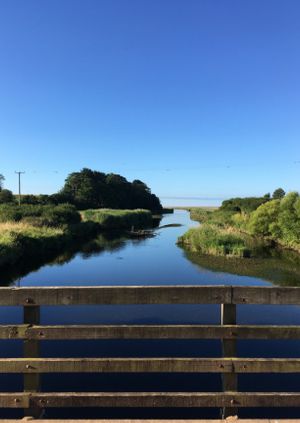
Perceiving Climate Change #2: Water
British Summer Time
This is a live-stream event
Tickets
Event Details
How can humans notice the subtle but fundamental processes of climate change? This online event will be the second in a series of free events across 2024 in which we will examine from a range of perspectives how people are striving to make climate change intelligible to human senses and cognitive processes. Our series of events examines how scientists, artists and others find ways to detect and narrate changes in the realms of ice, water and heat. For our second session we will concentrate upon the hydrosphere. Hosted by the Sheffield Hallam University Space & Place Group in conjunction with the Royal Geographical Society (Yorkshire & North East Regional Committee), this series of events will foster an exploratory, interdisciplinary conversation and we very much welcome participation from all disciplines.
Our presenters at this event will be:
Mel Lacey (Associate Professor, Department of Biosciences & Chemistry, SHU)
Nature’s witness: Using citizen science to monitor flood management in the era of climate change.
The South Yorkshire Source to Sea Nature-Based Solutions Partnership advocates a catchment-wide approach to natural flood management. Within Sheffield, a pilot project has been undertaken within the Limb Brook which included members of the public taking photographs at fixed positions over the course and after the project to observe subtle, incremental change to the waterscape over many months. What data does this library of community-generated images hold? What can we learn about impact of the natural flood management intervention on flooding, biodiversity and citizen science from the Limb Valley? And to what extent can the images reveal signs of climate change, and human adaptation to it?
James Lock - Co-Founder and Director at WeAreOpus
The River Dôn Project: Critical commons as agent and infrastructure
The River Dôn Project brings together a unique collaboration of organisations and citizens both internationally and locally to the region: https://www.theriverdon.org/. Including Dark Matter Labs, Don River Catchment Trust, WeAreOpus, Urban Flows Observatory, Sheffield Hallam University, South Yorkshire Sustainability Centre, Sheffield Data for Good and Lawyers for Nature. Applying a multi-disciplinary approach The River Dôn Project aims to model and demonstrate the future rights of nature, both as an agent and as critical civic infrastructure. It aims to show that a repositioning of critical commons like waterways in our governance, sensemaking and choice-making infrastructures would enhance our collective capabilities to address intersectional crises such as climate breakdown and biodiversity loss in the region. This talk will explore the ontological, complex and compounding nature of the social, economic and ecological crisis we currently face and the implications inherent in how we construct and deploy proofs of possibility or demonstrations of systemic transformation in response.
Jon Bridge & Julia Udall (Department of the Natural & Built Environment, SHU)
The Landscape Lab: interdisciplinary engagements with changing upland catchments
The landscape of the Upper Don catchment in South Yorkshire is also known as the 'Sheffield Lakelands', a moniker given in the 1950s by an enterprising local tour bus company. The 'lakes' in question are artificial - more than a dozen reservoirs built between 1830 and 1930 to supply the rapidly-growing industrial populations downstream. Now a central component of Sheffield's modern identity as 'The Outdoor City', these reservoirs and their hinterlands on the eastern fringe of the Peak District National Park form a complex natureculture in which human and more-than-human interactions are mediated by a hybridised and deeply modified waterscape. The fluctuating reservoir levels provide a graphic barometer in times of drought and floods, but the future of this landscape and its resilience and flourishing in the face of climate change depend on a deeper and richer understanding of the landscape system: its biodiversity and ecological functioning; human perceptions and understanding of the landscape as a basis for relationships of care and conservation; and a new more circular political economy in which value generated within the landscape system is returned to it. Here, we outline an interdisciplinary applied research agenda, the Landscape Laboratory, which seeks to address these critical issues in catchment management.
Andre Kong (Architect, Andre Kong Studio) www.andrekong.com IG: @andrekongstudio
Stories in Space: Inhabiting the Data of Uninhabitable FuturesThis presentation examines three recent projects by Andre Kong Studio, arguing that spatial design and architectural installations can enhance awareness of current and future challenges posed by climate change and related environmental damage. How can we make data more tangible? How can we inhabit data and tell its story? How can we engage communities for meaningful change? Our approach is playful, informative, and accessible. 'Whale in the Room' is an installation at the Newlyn Art Gallery & The Exchange in Penzance, exploring the effects of pollution on coastal communities. Community discussions took place under the looming burden of 380kgs of plastic waste collected from the sea near Penzance. Meanwhile, 'seeAsaw,' is an interactive hammock structure made from rescued fishing nets, is part of an educational project for young people on Governors Island, New York City. It aims to raise awareness of ghost nets and their impact on delicate marine environments, orchestrating a collective balancing act. And, 'A Cautionary Benchmark' presents inhabitable data in the form of a bench set on two levels, anticipating the storm flood level change predicted by 2030 in the River Thames in London.
Image credit: Luke Bennett
